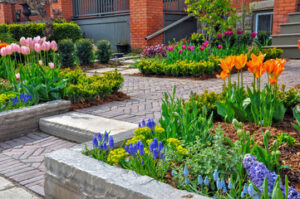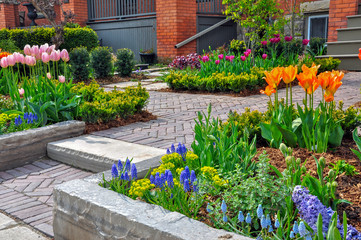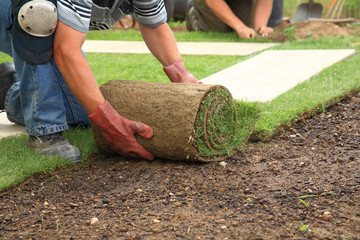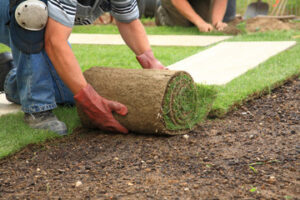Eccograss Landscaping is a great way to add value to your property and make your outdoor spaces more functional. It’s also good for the environment. Grass is a natural air cleaner and can reduce the need for air-conditioning in your home.
Visual details, like the shape and texture of plants and the size and color of hardscape elements can be used to create a theme for your landscape design. Lines can create focal points that guide the eye through your garden.
Landscape design is the process of designing a space for its aesthetic and functional purposes. It encompasses the use of various elements, including line, form, and color to create a balanced composition. It also includes the use of focal points, spatial organization, and repetition. Landscape design is a key component of sustainable development, and it is often required for environmental impact assessments and in planning projects such as road construction and dams.
Homeowners can also benefit from landscape design by increasing their property value and enhancing the quality of life. A well-designed landscape can increase the curb appeal of a home, provide an enjoyable environment for entertaining, and encourage wildlife to visit. It can even reduce pollution and energy costs. A well-designed landscape can be low maintenance and a source of pride. To achieve a beautiful and functional landscape, homeowners should consider hiring a professional.
A well-designed landscape should integrate the house with the garden. It should complement the style of the home, and it should not compete with it. In addition, it should include a focal point that captures the attention of the viewer and leads the eye to the rest of the landscape. A good example of this would be a water feature or a large tree.
Choosing the right plant species can make or break a design. Often, it is difficult to know what plants are best for a particular site, but a professional can help with this process. There are several things to keep in mind when selecting a plant species, including the soil type and climate of the area. A landscaping professional can also recommend drought-tolerant plants that require little watering.
There is a growing demand for landscapes that are both visually appealing and low-maintenance. Many homeowners are turning to landscape designers to create a space that they can enjoy with their families and friends. The landscape design process involves several phases, including site analysis, conceptualization, and detailed layouts. Moreover, the landscape designer should take into account the environmental and social impacts of the project. Lastly, the landscape designer should ensure that the landscape is designed with proper irrigation and drainage systems.
Irrigation system
Irrigation systems are a critical part of any landscape. They support healthy plant growth and water conservation while minimizing environmental impact. However, there are many factors to consider when designing an irrigation system. It’s important to consider how the system will work with your overall landscape design and how it will integrate with existing infrastructure. It’s also important to understand how the different irrigation options impact costs and long-term maintenance.
A well-designed irrigation system can reduce the amount of time spent on watering, improve plant health and appearance, and contribute to the property’s curb appeal. It can also help you save money by reducing water use and energy consumption. A landscape professional can help you plan and implement an irrigation system that suits your property’s needs.
When choosing an irrigation system, it’s important to consider the size of your yard and type of landscaping. For example, a large lawn may require more water than a smaller garden or flower bed. It’s also important to consider the types of plants you have and how much sun they get. A landscape professional can help you choose an irrigation system that will provide the right level of water to your plants.
During a site visit, a landscape professional will assess your current irrigation system and discuss your goals. They will take into account soil moisture, temperature, weather conditions, and other factors to determine the best solution for your landscape. They will also evaluate the existing irrigation system, including its components and installation. Once they have a clear understanding of your needs, they will make recommendations that reflect your budget and goals.
There are several types of irrigation systems, but the most popular ones include drip line systems and sprinklers. These systems deliver water directly to the roots of the plants, minimizing evaporation and runoff. They are particularly effective in sandy soils, where water tends to quickly evaporate. They are also useful in maintaining a uniform soil depth and reducing water stress in plants.
A landscape professional can install a smart irrigation system to ensure that your commercial property stays lush while conserving water. The technology in these systems allows them to monitor and adjust watering schedules based on real-time data. This helps prevent overwatering during rainy periods and under-watering during droughts. In addition, these systems can also track the watering history of each plant to ensure that it is receiving the proper amount of water.
Xeriscaping
Xeriscaping is a type of landscape that reduces the amount of water needed to keep grass and other plants looking lush. It uses native and adaptable plants, as well as drought-tolerant shrubs and ground covers. It also includes a variety of colorful flowers that attract birds and other wildlife. Xeriscaping is also known as water-conserving landscaping, drought-tolerant landscaping, and smart scaping. It can help homeowners save money by reducing their energy bills and minimizing water waste.
Using xeriscaping techniques can cut lawn care costs by up to 60%. It can also reduce the need for fertilizers and chemicals that are harmful to the environment. In addition, xeriscaping can provide food for local wildlife.
The first step in xeriscaping is to choose a design and color scheme that works for your climate. A horticulturist can help you choose drought-tolerant plants and create a sustainable garden that is both attractive and functional. It is important to consider the sun exposure of your property, as some plants thrive in full sun while others need shade.
When designing a xeriscape, it is best to group plants with similar water requirements together. This will help prevent over-watering less-demanding plants and ensure that your watering schedule is consistent. Ideally, you should also use mulch, as it will help retain soil moisture and reduce evaporation.
While xeriscaping can be expensive upfront, the long-term cost savings are significant. Xeriscaping is a great way to save on utility bills, and it can even qualify you for a rebate from your local water company. However, it is important to remember that a xeriscape garden will still need regular maintenance. Some of the most important maintenance tasks include mowing, weeding, pruning, and fertilizing.
A xeriscape can be a beautiful and sustainable alternative to traditional landscapes, but it will require careful planning and maintenance. It is also important to consider the amount of rainwater that your yard generates, and how you can re-use it. Some xeriscape ideas include using porous pavers, incorporating rain gardens, and directing storm water runoff into garden areas.
Some xeriscaping plants may have thorns or prickly edges, which is a concern for households with small children and pets. It is recommended to place these plants in areas that are less accessible to young children and pets.
Maintenance
Landscaping is a creative and technical profession that combines art, science, and engineering to create beautiful outdoor spaces. It transforms outdoor areas into tranquil gardens, comfortable outdoor living areas, and functional recreational areas. It can also increase the value of property and reduce the impact on the environment. In order to ensure that your landscape continues to provide maximum benefits, it is important to have a well-planned maintenance plan in place.
Landscape maintenance involves the management of both the hardscape and softscape elements of the landscape. Softscape includes living horticultural elements such as flowers, trees, and shrubs. The maintenance of these elements requires careful attention to the climate and soil conditions in which they grow. For example, certain plants may thrive in sunny spots while others require shade. It is also important to understand the life cycle of each plant so that you can prune, fertilize, and replant as needed.
Hardscapes are non-living elements such as paving stones, garden edging, retaining walls, and walkways. The maintenance of these elements includes inspecting them for deterioration and damage, cleaning dirt and debris from their surfaces, and resetting dislodged masonry items. In addition to these tasks, maintenance may also include mulching to retain moisture, reseeding lawns, and spraying herbicides for weed control.
Keeping up with seasonal landscaping maintenance can help your commercial landscape flourish throughout the year. It can also improve the overall appearance of your facility and promote customer satisfaction. It is also an excellent way to demonstrate your company’s commitment to sustainability. You can present impact data and visuals to show how your sustainable practices save the company money and improve its bottom line.
Maintaining a quality landscape takes time and effort, but the rewards are great. A well-maintained commercial landscape can enhance your property’s aesthetic and increase its value. It can also be a focal point for your marketing and branding efforts. A well-maintained landscape will also add to your company’s reputation, making it more attractive to customers and potential employees. By following these tips, you can make your commercial landscape look like new and attract more business.



